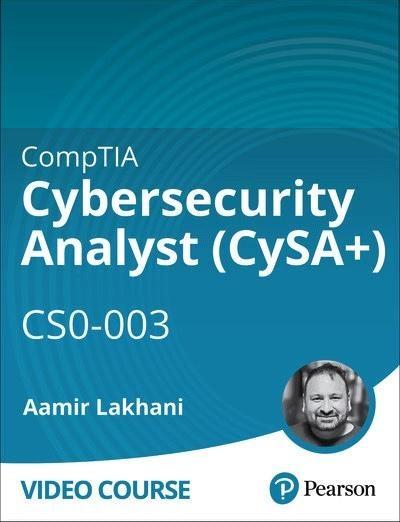English | MP4 | AVC 1280×720 | AAC 44KHz 2ch | 122 Lessons (10h 21m) | 2.80 GB
Aamir Lakhani is a leading senior blockchain researcher. Mr. Lakhani advises corporations and government entities on blockchain initiatives, applications, and implementation strategies. He has been involved in several initial coin offerings (ICOs) as an advisor. Additionally, Aamir is a leading cyber security researcher and has uncovered vulnerabilities in several blockchain implementations and deployed cyber security blockchain solutions. Aamir has also been heavily involved in the cryptocurrency investments and mining operations. He is an active blogger at the popular site Dr. Chaos (www.DrChaos.com) and has authored several books.
Table of Contents
Introduction
CompTIA Cybersecurity Analyst (CySA+) CS0-003 Introduction
Lesson 1 Importance of System and Network Architecture Concepts in Security Operations
Learning objectives
Log ingestion–Part 1
Log ingestion–Part 2
Operating system (OS) concepts
Infrastructure concepts
Network architecture
Identity and access management
Encryption
Sensitive data protection
Lesson 2 Analyze Indicators of Potentially Malicious Activity
Learning objectives
Network-related
Host-related
Application-related
Other
Lesson 3 Tools or Techniques to Determine Malicious Activity
Learning objectives
Tools
Tools–Part 2
Common techniques
Common techniques–Part 2
Common techniques–Part 3
Programming languagesscripting
Lesson 4 Threat-Intelligence and Threat-Hunting Concepts
Learning objectives
Threat actors
Threat actors-Part 2
Collection methods and sourcesConfidence levels
Threat hunting
Lesson 5 Importance of Efficiency and Process Improvement in Security Operations
Learning objectives
Standardize processes
Streamline operations
Technology and tool integration
Lesson 6 Implement Vulnerability Scanning Methods and Concepts
Learning objectives
Asset discovery
Special considerations
Internal versus external scanning
Agent versus agentless
Credentialed versus non-credentialed
Passive versus active
Static versus dynamic
Critical infrastructure
Critical infrastructure–Part 2
Lesson 7 Analyze Output from Vulnerability Assessment Tools
Learning objectives
Network scanning and mapping
Web application scanners
Vulnerability scanners
Debuggers
Multipurpose
Cloud infrastructure assessment
Secure coding best practices
Input validation
Output encoding
Session management
Authentication
Lesson 8 Analyze Data to Prioritize Vulnerabilities
Learning objectives
Common Vulnerability Scoring System (CVSS) interpretation
Validation
Context awareness
Exploitabilityweaponization
Asset value
Zero-day
Lesson 9 Recommend Controls to Mitigate Attacks and Software Vulnerabilities
Learning objectives
Cross-site scripting
Overflow vulnerabilities
Data poisoning
Broken access control
Cryptographic failures
Injection flaws
Cross-site request forgery
Directory traversal
Insecure design
Security misconfiguration
End-of-life or outdated components
Identification and authentication failures
Server-side request forgery
Remote code execution
Privilege escalation
Local file inclusion (LFI)remote file inclusion (RFI)
Lesson 10 Analyze Data to Prioritize Vulnerabilities
Learning objectives
Compensating controls
Control types
Patching and configuration management
Maintenance windows
Exceptions
Risk management principles
Policies, governance, and service-level objectives (SLOs)
Prioritization and escalation
Attack surface management
Secure coding best practices
Secure software development life cycle (SDLC)
Threat modeling
Lesson 11 Concepts Related to Attack Methodology Frameworks
Learning objectives
Cyber kill chains
Diamond Model of Intrusion Analysis
MITRE ATT&CK
MITRE ATT&CK–Part 2
Open Source Security Testing Methodology Manual (OSS TMM)
OWASP Testing Guide
Lesson 12 Incident Response Activites
Learning objectives
Detection and analysis
Containment, eradication, and recovery
Lesson 13 Preparation and Post-incident Activity Phases of the Incident Management Life Cycle
Learning objectives
Preparation
Post-incident activity
Lesson 14 Vulnerability Management Reporting and Communication
Learning objectives
Vulnerability management reporting
Compliance reports
Action plans
Inhibitors to remediation
Metrics and key performance indicators (KPIs)
Stakeholder identification and communication
Lesson 15 Preparing for and Taking the CySA+
Learning objectives
Understanding the test
Types of test questions
Increasing your chances for passing the test
Lesson 16 Next Steps
Learning objectives
What I learned
Module 1 Security Operations
Module Introduction
Module 2 Vulnerability Management
Module Introduction
Module 3 Incident Response and Management
Module Introduction
Module 4 Reporting and Communication
Module Introduction
Module 5 Certification Exam
Module Introduction
Summary
CompTIA Cybersecurity Analyst (CySA+) CS0-003 Summary
Resolve the captcha to access the links!
